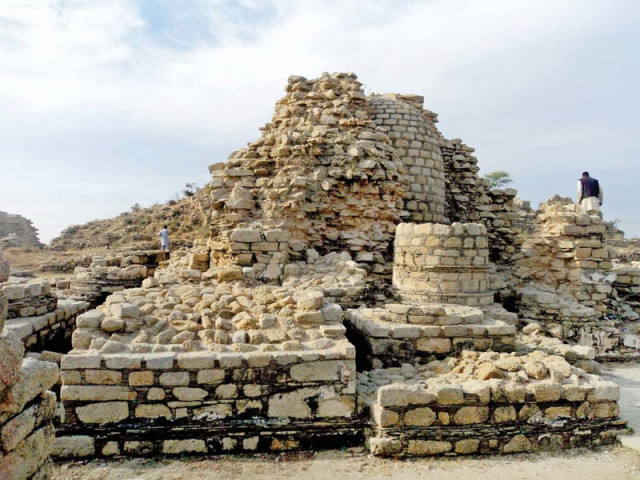Government negligence: Past royal abode assaulted by today’s vandals
Gandhara’s ruins are being abused by visitors and town builders.

The famous Rani Gat mound in Gandhara region. PHOTO: FAZAL KHALIQ
The rani of Gandhara couldn’t get any queenlier: fond of fresh water from the Indus, she would order her palace courtiers to form a human queue all the way from the Peshawar Valley to the rivers of Punjab. The man closest to the river would scoop water to pass it on, and the process would continue till a handful of the Indus had crossed several miles to reach the queen.
Dwelling between the 5th and 2nd century BCE, this Buddhist regal figure has been a celebrated part of a rich folklore – songs and stories of which still echo from the coffee-hued ruins of ‘Rani Gat’ in Nogram village of Buner district.

‘Rani’ translates from Pashto as ‘queen’ while ‘Gat’ as ‘rock’ or ‘stone’. The famous mound of Rani Gat is regarded as the site where the queen would sit during her evenings for leisure. Sadly, this fascinating relic is a victim of vandalism and poor preservation techniques.
“People visit here and climb up the walls most carelessly. The government must take serious notice of it and guards must do their duty and stop people and animals from destroying it further. There must be proper system for the visitors, complete with guides, historical material and drinking water facilities etc. Furthermore, the government must stop the illegal and frequent excavation in this area,” says Haider Ali Akhundkhel, a researcher and author who visits the site frequently. “This is the largest site in the Gandhara region. Sadly, the government does not realise its importance.”

Not only are these ruins famous as the abode of a historic queen, but also as home to invaluable remains of shrines and monasteries, bearing evidence to a glorious Buddhist learning centre which the Gandhara civilisation begot. The legacy of the area includes remains from the Mauryan and Kushan empire, along with Greek influences emerging from Alexander the Great’s arrival to Taxila in 326 BCE.
The Buner site includes a room carved out in a rock, of a unique design with holes and niches in it, where sculptor would sit along with carved Buddha statues. The architecture follows a style which is characteristic to the civilisation – making it an invaluable study resource.
Hazir Gul, a member of the Suvastu Arts and Cultural Association told The Express Tribune that the site is being destroyed by locals who pilfer stones from it and use it in their buildings. He appealed the provincial government to take immediate steps for its conservation.
Director Archaeology and Museum, Dr Shah Nazar Khan said, “We have some projects regarding its conservation in pipeline, work on which will soon be initiated”
A series of excavations were carried out at the site in 1984, 1986, and 1989 with the help of Kyoto University in Japan, as a result of which several bronze coins belonging to the Kushan empire were discovered. These coins bore the Kharosti script – a script used to write the Sanskrit language in Gandhara.
Published in The Express Tribune, February 4th, 2013.













COMMENTS
Comments are moderated and generally will be posted if they are on-topic and not abusive.
For more information, please see our Comments FAQ